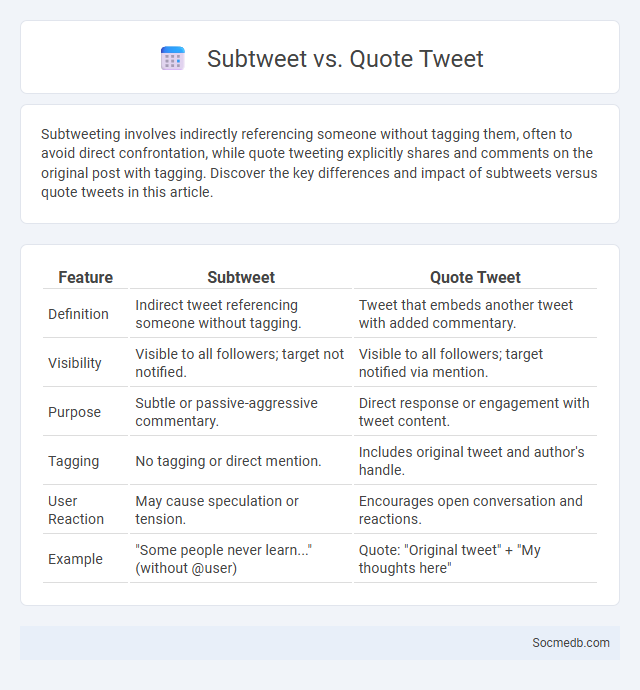
Photo illustration: Subtweet vs Quote Tweet
Subtweeting involves indirectly referencing someone without tagging them, often to avoid direct confrontation, while quote tweeting explicitly shares and comments on the original post with tagging. Discover the key differences and impact of subtweets versus quote tweets in this article.
Table of Comparison
| Feature | Subtweet | Quote Tweet |
|---|---|---|
| Definition | Indirect tweet referencing someone without tagging. | Tweet that embeds another tweet with added commentary. |
| Visibility | Visible to all followers; target not notified. | Visible to all followers; target notified via mention. |
| Purpose | Subtle or passive-aggressive commentary. | Direct response or engagement with tweet content. |
| Tagging | No tagging or direct mention. | Includes original tweet and author's handle. |
| User Reaction | May cause speculation or tension. | Encourages open conversation and reactions. |
| Example | "Some people never learn..." (without @user) | Quote: "Original tweet" + "My thoughts here" |
Understanding Twitter Terminology: Subtweet and Quote Tweet
Subtweet refers to a tweet mentioning someone indirectly without using their handle, often used to comment on or criticize without explicit attribution. Quote tweet allows users to share another tweet while adding their own comment, enhancing context and engagement by combining original content with personal input. Understanding these terms helps users navigate Twitter's communication style and interaction dynamics more effectively.
What is a Subtweet?
A subtweet is a social media post on platforms like Twitter that indirectly references a person without mentioning their username, often used to express opinions or emotions subtly. This technique allows users to comment on situations or individuals without direct confrontation, making it a popular form of digital communication and social commentary. Understanding subtweets can help you navigate online interactions and interpret underlying messages in social media conversations.
What is a Quote Tweet?
A quote tweet is a social media feature that allows users to retweet someone else's post while adding their own commentary or perspective. This function enhances engagement by enabling users to share content with personalized context, fostering discussions and expanding the original message's reach. Twitter's quote tweets are widely used to provide opinions, reactions, or additional information directly linked to the source tweet.
Key Differences: Subtweet vs Quote Tweet
A subtweet is a tweet that indirectly references someone without tagging their handle, often used to express opinions or criticisms subtly, while a quote tweet explicitly shares another user's tweet with your added comments or reactions. Your use of subtweets can influence your audience by creating intrigue or avoiding direct confrontation, whereas quote tweets provide transparency by linking directly to the original content, enhancing engagement through clearer context. Understanding these distinctions helps you strategically navigate social media interactions with nuance and clarity.
Purpose and Intent Behind Subtweeting
Subtweeting serves as a subtle form of communication on social media platforms, allowing users to express opinions or frustrations indirectly without naming individuals. This behavior often aims to generate engagement, provoke thought, or signal in-group belonging while avoiding direct confrontation. Understanding the intent behind subtweeting reveals underlying social dynamics and the desire for attention or validation within digital communities.
How Quote Tweets Drive Conversation
Quote Tweets amplify your reach by allowing you to add personal commentary to shared content, sparking deeper engagement and diverse perspectives. This feature encourages dynamic interaction, as followers respond not just to the original tweet but also to your unique take on it. Through Quote Tweets, conversations evolve organically, increasing visibility and fostering community dialogue around trending topics.
Privacy and Anonymity: Subtweet vs Quote Tweet
Protecting your privacy on social media involves understanding the differences between subtweeting and quote tweeting. Subtweeting allows you to mention someone indirectly without linking to their account, providing a layer of anonymity and reducing digital footprints. Quote tweeting openly shares content with your followers, making your identity and commentary visible in the conversation.
User Perception: Reactions to Subtweets and Quote Tweets
User perception of subtweets and quote tweets varies significantly, often influenced by the content's tone and intent. Subtweets, being indirect and ambiguous, can provoke curiosity or confusion, leading users to speculate about the underlying target or message. Quote tweets provide clearer context through added commentary, which can intensify engagement by framing opinions or inviting discussions within the social media community.
Social Impact: Effects on Online Communication
Social media transforms online communication by enabling instant connectivity and fostering global communities, enhancing information sharing and collective engagement. It influences social behaviors through viral trends, peer interaction, and the amplification of diverse voices, reshaping cultural norms and public discourse. The platform algorithms also impact content visibility, shaping societal narratives and influencing public opinion on a broad scale.
Best Practices: When to Subtweet or Quote Tweet
Subtweeting and quote tweeting are strategic tools for managing your social media presence and engaging conversations without direct confrontation. Best practices recommend subtweeting when addressing sensitive issues indirectly to avoid escalating conflicts while using quote tweets to add context or commentary to someone's post, enhancing clarity and fostering dialogue. You should consider your audience and intent carefully to maintain positive relationships and effective communication on platforms like Twitter.
 socmedb.com
socmedb.com